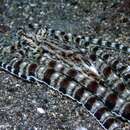Mimic octopus (Thaumoctopus mimicus)
provided by EOL authors
A group of scientists discovered the mimic octopus off the coast of Sulawesi, Indonesia in 1998. The species was thought to only inhabit the islands of Indonesia until Darren Coker spotted one was spotted near the Great Barrier Reef in 2010. This octopus was on a shallow sand flat near Lizard Island (1). The mimic octopus lives in nutrient-rich estuarine bays of Indonesia and Malaysia primarily in shallow warm waters about 15 meters deep in the Indo-West Pacific. It prefers obscuring murky and muddy sea floors to blend in with its natural brown, beige color.
The mimic octopus grows to an average length of 60cm (2 feet) and its arms grow to be 62 cm (25 in long). The natural colour is light brown/beige, but the octopus may adopt a striped white and brown pattern to scare off predators by appearing to be poisonous. It is unknown if it is poisonous to predators. It is assumed that if it is not considering that it is poisonous, there would be no need to camouflage themselves as all the other poisonous sea animals (1).
Most octopuses can use pigment sacs (chromatophores) to change their skin colour and texture to blend in with their surrounding background, such as algae-encrusted rock and nearby coral. The mimic octopus can blend in with backgrounds and can mimic the shape of objects, such as coral and rock, and some animals (1). It is the only known aquatic species that impersonates an array of different sea animals via changes in behaviour, coloration and body posture, depending on what predator it is trying to elude (2). It uses mimicry as a primary defense and is reputed to mimic up to 15 species of other local marine organisms. When motionless, it assumes body patterns and postures resembling small sponges, tube-worm tubes or colonial tunicates in an open sand habitat. The barren homelands provided the impetus to evolve mimicry (4). The octopus is intelligent enough to discern which dangerous sea creature to impersonate that will present the greatest threat to its current possible predator. When an octopus was attacked by territorial damselfishes, it mimicked the black-and-yellow banded sea snake, a predator of damselfishes (3).
Most of the animals it mimics are poisonous. Its shape shifting is probably a deliberate survival strategy. The animals it mimics include:
1. Lionfish: This poisonous fish has brown and white stripes and spines that trail behind it on all sides. When the octopus changes its colour and shapes its eight legs to look like spines, it seems to be a highly venomous creature that should be avoided.
2. Sea snake: If under attack, the octopus may hide in a hole except for two of its legs, which it sticks out in opposite directions. What remains in view is a long thin object with white and black bands running across the elongated body. Many predators avoid tangling with the highly venomous sea snake and swim away, leaving the octopus unharmed.
3. Flatfish: The octopus mimicsa flatfish by pulling its arms together on one side and flattening out its body while moving forward along the ocean floor. It mimics the shape, swimming actions, speed, duration and sometimes the colour of swimming flounders. During flounder mimicry, it is actively moving and conspicuous; immediately before and after flounder mimicry, it is camouflaged and motionless (sitting or very slowly crawling). It uses flounder mimicry when its movement would give away camouflage in an open habitat.
4. Jellyfish – The octopus may act as a Jellyfish to frighten and discourage predators. It puffs up its head and siphon and lets its arms trail behind it. It mimics the motions of a jellyfish swimming by going to the surface and slowly sinking with its arms spread evenly around its body.
The mimic octopus can be classified as a hunter or a forager. It is thought to be a hunter, as it can stalk prey and hunt down small fish and catch them. More often, however, it forages for food by using a jet of water through its siphon (funnel) to glide over the sand, while searching for prey, and using its slender tentacles to reach into crevices in coral and holes in the sand, using its suction cups to grab small crustaceans and eat them. As it prefers to live in shallow, murky waters, it is believed that it feeds almost exclusively on small fish, crabs and worms, which are the only two animals that are common to those conditions that the octopus can survive on. The octopus isnot known to eat any type of plant or vegetation.(1). It may use aggressive mimicry to approach wary prey, such as mimicking a crab as an apparent mate, only to devour its deceived suitor. It prefers river mouths and estuaries to reefs, which give more shelter to other types of octopus. This is because it can impersonate poisonous fish and hides out in the open.
Males die within a few months after mating. A fertilized female lays about 200,000 eggs, which she hangs these eggs in strings from the ceiling of her lair or individually attaches them to the substratum. She cares for the eggs, guarding them against predators and gently blowing currents of water over them so they get enough oxygen. She does not eat for about a month while she takes care of the unhatched eggs. She dies at around the time the eggs hatch (5). The mimic octopus is not thought to be at risk of extinction.

